|

CASARABONELA -
FESTIVALS
Easter Week
Processions take place throughout the whole
week and the floats are carried on the
shoulders of members of the brotherhoods and
religious associations following a path that
leaves the church and makes its way through
the narrow, winding streets of the town
centre.
This event constitutes a very important part
of the town’s rich historic-ethnological
heritage since most of the brotherhoods and
organisations were founded and became
organised during the 17th, 18th and 20th
Centuries.
Easter Week falls in March or April,
depending on the year.
The Passion (Easter
Sunday, Holy Monday and Holy Tuesday)
The Passion is, without doubt, one of the
most important cultural displays of the
village of Casarabonela that takes place on
Easter Sunday, Holy Monday and Holy Tuesday
and is the staging of a sequence of scenes,
in real time and continuous in its religious
symbolism.
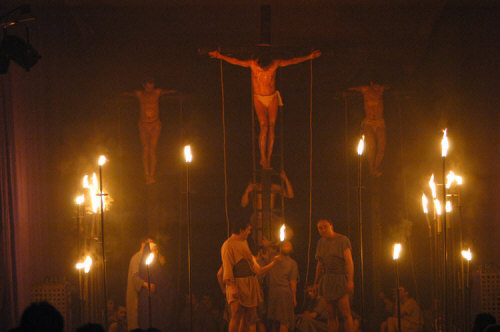
Instead of an outdoor stage, they
concentrate on presenting a different,
interior view: the Church of Santiago
Apóstol as a spiritual refuge for the whole
town. They erect an enormous, rough wooden
cross in the centre that symbolises the
ritual and the absurdity of war.
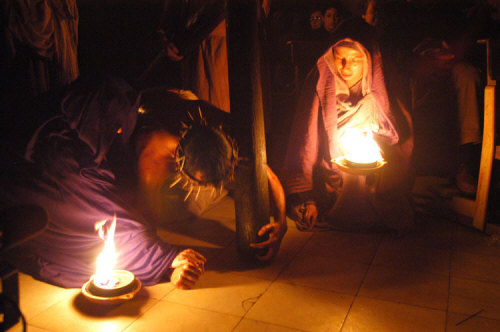
Following this, a long series of scenes
unfolds, charged with emotion and displaying
a quality and truthfulness worthy of the
highest respect. The Passion has been
portrayed since 1984 and is, according to
the newspaper “El Pais”: “one of the unusual
events that you’d more likely expect to see
in a cultural metropolis than in a 19th
Century church in a mountain town of less
than 2500 inhabitants”. But it is precisely
this re-enactment of the death and
resurrection of Christ that gives meaning to
the celebration, and even the use of
decoration and scenery is forgone in order
to concentrate on the message.
The May Crosses (the 3rd of May)
On the Day of the Cross, the numerous niches
(45 have been counted) take on a very
special role and the crosses in their
interior and their surroundings are
beautifully decorated with flowers in order
to honour this celebration.
At nightfall, the party continues with
popular open-air dancing and the traditional
burning of cloth figures.
There are still diverse theories as to the
meaning, origin and function of the small
religious monuments (the niches) that appear
dotted around the entire village. See
“niches” in the section entitled “Main
Monuments”.
Fair of Santiago
Apóstol (St. James de Apostle) (last week of
July)
For several days the people decorate the
village streets in all the colours of the
rainbow for the festival in honour of
Santiago de Apóstol. The Santiago de Apóstol
procession takes place on the first day of
the fair; a curiosity in itself since only
the women participate. A large and varied
program of events takes place throughout the
week, including popular and traditional
performances. This fair is one of the most
eagerly awaited by the locals, and is a time
for getting together with family and
friends.
Atalaya Flamenca
(beginning of July)
Since the 80s this meeting has been
organised between flamenco singers and
guitarists from all over Andalusia,
accompanied by performances from local
groups. From amateur flamenco singers to
professional artists, this festival attracts
them all.
Cultural Week (end of
August)
The Cultural Week sees a whole variety of
cultural and sporting activities with
participation from children, young people
and the elderly alike. As a symbol of the
rich folklore of Casarabonela, the visitor
can sample the traditional dishes and enjoy
the displays of paintings and ceramics, as
well as the handicraft products, concerts,
theatre, cinema, etc…
There is also a competition for the best
floral house decoration, the winners of
which promise to maintain their house
decorations for the whole year.
Pilgrimage of the
Virgen del Rosario (7th of October)
The pilgrimage is celebrated, in honour of
the Virgin of the Rosary, patron saint of
the town of Casarabonela.
The pilgrims set off from the town in
procession, carrying the Virgin in a covered
wagon pulled by oxen, and take the El Burgo
road until they reach Puerto Martinez, 5 km
away. Once there, d various festive and
entertainment activities take place.
Certamen de los
Pastores
This event has no fixed date and can come
before or after the Virgen de Los Rondeles
Procession, (on the 12th of December).
Shepherds from various areas of the Malaga
province come together to take part in this
contest which takes place in the Santiago
Apóstol Parish Church, a place with superb
acoustics and the perfect size for this type
of event.
The Casarabonela shepherd group has a very
unique character; its members, spanning
several generations, play instruments like
the bass drum, the bell, the mortar, or an
empty bottle; but the most remarkable
instrument used by this unique group of
musicians is the Moorish castanet, a very
special type of castanet and the only one of
its kind. The sound produced is very
characteristic and is more than enough to
warrant the group’s own, distinct
personality.
The children’s shepherd group also plays a
very important part; integrating the next
generation of young shepherds.
Since 1983 the Virgen de los Rondeles
Procession has taken place and the Friends
of Rondeles Association has edited the
popular Casarabonela Christmas carols, the
ancient songs of the villagers.
The Friends of Rondeles Association wanted
this meeting to bear the name of one of its
founding members, Antonio Martin, (known to
the world as “Martin”), inhabitant of the
village and great defender of its popular
traditions.
LOS RONDELES
FESTIVAL (12th of December)
More information:
www.losrondeles.com
Observation: The Virgen of the Rondeles
Festival was declared the National Festival
of Tourist Interest for Andalusia towards
the end of the year 2001.
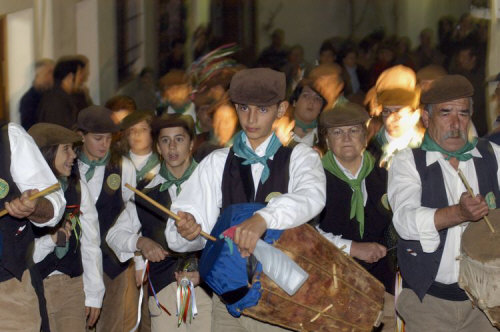
The theories that attempt to explain this
phenomenon are many and varied. What is
certainly beyond a doubt is that, since the
beginning of the 18th Century, a group of
oil millers have carried their burning
wicker baskets in procession during this
festival, in a simple thanks to the Devine
Shepherd for the harvest.
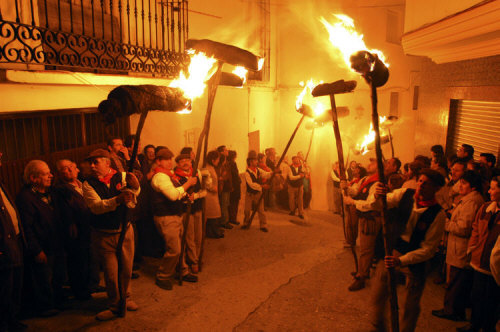
After the Civil War the Festival was not
celebrated for several years. It began
afresh in the 1970s, albeit with substantial
modifications.
The events begin around 10pm with the
blessing of the fire that will be used to
light the oil covered baskets. This is when
the numerous inhabitants begin a walk that
runs from the Veracruz Chapel up to the
highest part of the village, where the
Santiago Apostol Parish Church is found.
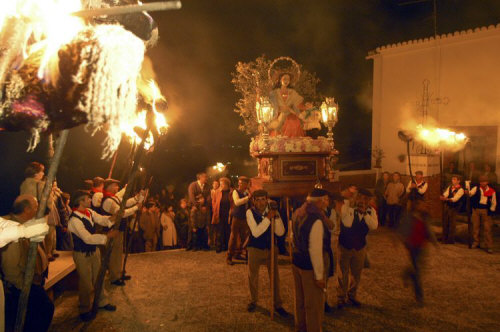
Towards midnight the entourage formed by the
members of the Rondeles association, the
shepherds, and the numerous group of
participants ends its journey at the
Santiago Church. The Rondeles members wait
around the entrance to the temple until the
Virgin has been carried in to the building,
where she will remain for the next few days.
But the celebrations do not end there; in
the Casarabonela village square, the most
entertaining part of the fiesta can be
enjoyed. There’s nothing better than a hot
cup of chocolate to keep the cold at bay,
together with slices of bread with garlic
and olive oil - “toasties” - and above all,
doughnuts, the Moorish product par
excellence, which delight the locals and
visitors alike.
|